QUÉBEC


ORIGIN OF PROVINCE NAME: From an Algonquin Indian word meaning "narrow passage" or "strait," referring to the narrowing of the St. Lawrence River at what is currently Québec City.
NICKNAME: La Belle Province (The Beautiful Province).
CAPITAL: Québec City.
ENTERED CONFEDERATION: 1 July 1867.
MOTTO: Je me souviens (I remember).
COAT OF ARMS: Consists of a shield with a royal crown above and a golden scroll with blue borders bearing the provincial motto below. The upper third of the shield has three white upright fleur-de-lis on a blue background, the middle third has a gold leopard on a red background, and the lower third a sugar maple sprig on a gold background.
FLAG: The flag of Québec, also known as the "fleurdelisé" flag, consists of a white cross on a sky-blue field, with an upright fleur-de-lis centered in each of the four quarters.
FLORAL EMBLEM: White garden (madonna) lily.
PROVINCIAL BIRD: Snowy owl.
TREE: Yellow birch.
TIME: 8 AM AST = noon GMT; 7 AM EST = noon GMT.
1 LOCATION AND SIZE
Québec is almost entirely surrounded by water. It is bordered on the north by the Hudson Strait; on the east by Labrador (the mainland portion of the province of Newfoundland); on the southeast by the Gulf of St. Lawrence; on the south by New Brunswick and the US states of Maine, New Hampshire, Vermont, and New York; on the southwest and west by Ontario; and on the west and northwest by James Bay and Hudson Bay. Québec has an area of 594,857 square miles (1,545,680 square kilometers), three times that of France and seven times that of Great Britain. It is the largest of Canada's provinces.
2 TOPOGRAPHY
From north to south, Québec takes in three main geographical regions: the Canadian Shield, the St. Lawrence lowlands, and the Appalachian Mountains. Extending from the shores of the Canadian Arctic to the Laurentians, the Canadian Shield covers about 60 percent of the land mass, and is the world's oldest mountain range. The highest point in Québec is located in this region; it is Mount D'Iberville—elevation 5,420 feet (1,652 meters) above sea level—located in the Torngat Mountains in extreme northeastern Québec.
The St. Lawrence River, the province's dominant geographical feature, links the Atlantic Ocean with the Great Lakes. The St. Lawrence lowlands are dotted with more than a million lakes and rivers. To the south, the foothills of the Appalachians separate Québec from the United States. Québec's tens of thousands of lakes and rivers account for 16 percent of the world's fresh water supply.
Of Québec's total land area, 51 percent is forested area, 27 percent is arctic and forest tundra, and 22 percent is taiga (a transitional area between forests and tundra, with scattered trees).
3 CLIMATE
Southern Québec, along the St. Lawrence River, has a temperate continental climate, while the bay and Gulf of St. Lawrence have a temperate maritime climate. Permafrost reigns in the northern part of the Canadian Shield; only dwarf birches and lichen are able to grow there. Average temperatures for January are 16°F (-8.7°C) in Montréal, 10°F (-12.1°C) in Québec City, 8°F (-13.2°C) in Baie-Comeau, and -10°F (-23.3°C) in Kuujjuak. In July, average temperatures are 71°F (21.8°C) in Montréal, 66°F (19.1°C) in Québec City, 62°F (16.8°C) in Baie-Comeau, and 53°F (11.4°C) in Kuujjuak. The warmest recorded temperature in Québec was 104°F (40°C) on 6 July 1921 at Ville Marie and the coldest was -66°F (-54.4°C) on 5 February 1923 at Doucet.
Québec Population Profile
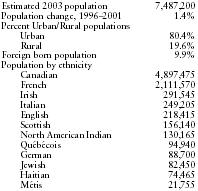
| Estimated 2003 population | 7,487,200 |
| Population change, 1996–2001 | 1.4% |
| Percent Urban/Rural populations | |
| Urban | 80.4% |
| Rural | 19.6% |
| Foreign born population | 9.9% |
| Population by ethnicity | |
| Canadian | 4,897,475 |
| French | 2,111,570 |
| Irish | 291,545 |
| Italian | 249,205 |
| English | 218,415 |
| Scottish | 156,140 |
| North American Indian | 130,165 |
| Québécois | 94,940 |
| German | 88,700 |
| Jewish | 82,450 |
| Haitian | 74,465 |
| Métis | 21,755 |
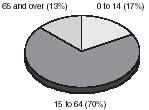
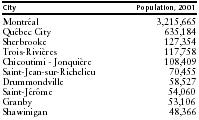
| City | Population, 2001 |
| Montréal | 3,215,665 |
| Québec City | 635,184 |
| Sherbrooke | 127,354 |
| Trois-Rivières | 117,758 |
| Chicoutimi-Jonquière | 108,409 |
| Saint-Jean-sur-Richelieu | 70,455 |
| Drummondville | 58,527 |
| Saint-Jérôme | 54,060 |
| Granby | 53,106 |
| Shawinigan | 48,366 |
4 PLANTS AND ANIMALS
The relatively temperate climate of the south is hospitable for a wide variety of native as well as imported European plants. A myriad of migratory ducks and
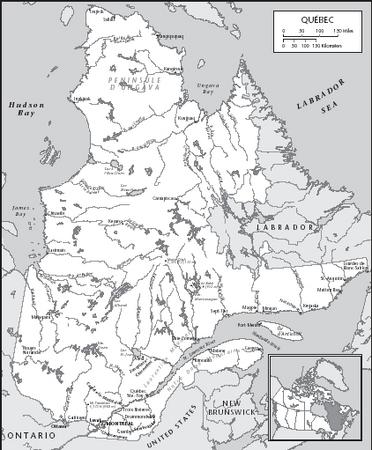
5 ENVIRONMENTAL PROTECTION
The generation of solid wastes in 2000 was 6,912,000 metric tons. That total was equivalent to 940 kilograms (2,072 pounds) per person, the highest amount among the provinces. Québec produces about 22 percent of Canada's hazardous waste. Annual air pollution emissions include about 2.5 million tons of nitrogen dioxide and carbon monoxide (gases that cause smog), some 930,000 tons of sulfur dioxide and nitrogen oxide compounds (gases that produce acid rain), and the equivalent of about 17 million tons of carbon dioxide. In 2001, Québec produced the third highest level of greenhouse gas emissions in Canada (12.5 percent), behind Alberta and Ontario.
For decades, tons of sulfur dioxide and other chemicals were put into the air by factories in the American Midwest. Prevailing winds carry the toxins northward across Québec, Ontario, and the northeastern United States. As a result, poisonous rainclouds release acidic rain on the lands and lakes to the north. By 1980, hundreds of lakes in Québec and Ontario were severely damaged; forests and farms were affected as well.
The Montréal Protocol is an international treaty that seeks to reduce and eliminate the consumption of substances believed to deplete the ozone layer. The protocol came into force on 1 January 1989 and by 2003 had been ratified by 183 other nations to reduce the global consumption of chlorofluorocarbons (CFCs) and halons to 1986 levels. Since its adoption, the protocol has been amended four times to take into account progress made in scientific knowledge related to ozone depletion. The amendments led to the elimination of the production of halons in 1994, and to the elimination of the production of CFCs in developed countries in 1996. The amendments also set 2030 as the deadline for the elimination of the production of hydrochlorofluorocarbons (HCFCs).
6 POPULATION
By 1931, some 63 percent of Québec's population lived in cities, up from 36 percent in 1901. During those thirty years, the population of Montréal doubled to over 818,000, accounting for over 28 percent of the province's growth.
Québec's 2001 population of 7.24 million is equivalent to about one-quarter of the national total. The majority of Québeckers live in urban centers located along the St. Lawrence. Montréal had a population of 3.22 million in 2001, making it the second largest city in the nation.
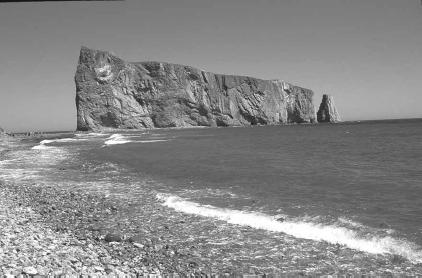
In 2001, Québec and Nova Scotia had the oldest populations in Canada, with median ages of 38.8 years. In 2001, young people aged 19 and under accounted for only 24 percent of Québec's population, the lowest proportion in Canada. The number of elderly people aged 80 and older in Québec rose 42 percent from 1991 to 2001.
7 ETHNIC GROUPS
In the early years of French settlement, men significantly outnumbered women. The imbalance between males and females prevented many men from finding a wife from within their own community. By the 1670s, French fur traders started marrying native women, and their descendants were absorbed into their mothers' cultures. The children of the Europeans and the natives became known as the Métis, who eventually developed into a distinct cultural group.
Québec has more than two million people of French origin, 374,500 of British origin, and about 130,165 Aboriginals (Native Peoples, including Mohawk, Cree, Montagnais, Algonquin, Attikamek, Micmac, Huron, Abenaki, and Naskapi). Eleven distinct Aboriginal nations in Québec have been recognized by the federal Indian Act; the largest native band in the province is at Kahnawake. Montréal is one of Canada's most ethnically diverse metropolitan areas, with large Italian, Greek, Portuguese, and Chinese communities, as well as a notable South American, Arab, and Asian population.
Ethnic divisions between francophones (speakers of French) and anglophones (speakers of English) have recently been replaced by tensions between ethnic Europeans and Aboriginals. In 1990, a group of Mohawks protested the rezoning of a burial ground in Oka, resulting in armed confrontation and a three-month siege by federal troops.
8 LANGUAGES
Most of North America's francophones live in Québec. French is the mother tongue of 80.9 percent of Québeckers, while 7.8 percent cite English as their mother tongue.
The Royal Commission on Bilingualism and Biculturalism, established in 1963, documented the ways that the French language and culture were given a secondary position in Canadian society. After the commission issued its findings in 1969, there was a tide of legislation requiring the use of both English and French in public activities, which stirred up opposition outside Québec. In 1977, Québec's National Assembly adopted the Charter of the French Language, with the aim of making French the language of the government, judicial system, and all official signs, as well as the customary language of work, instruction, communications, commerce, and business.
In addition to French and English, some 35 other languages are spoken by provincial residents, with Italian, Arabic, Spanish, and Greek the most prevalent. Each Aboriginal nation uses its own language, with the exception of the Abenakis, Huron-Wendats, and Malecites.
9 RELIGIONS
With the overwhelming majority of its residents Roman Catholic, Québec is unique to Canada. After 1840, the Catholic church started to grow across Québec, and many religious orders from France established themselves. Catholics established their own lay, burial, and philanthropic societies.
Eighty-three percent of the population are Roman Catholic, or about 5,939,700 people. Only 4.7 percent of the population, or about 335,590 people, are Protestant, including Anglicans, members of the United Church of Canada, Baptists, Pentecostals, Presbyterians, and Lutherans. Québec also has about 108,620 Muslims, 89,915 Jews, 100,375 people of Eastern Orthodox faith, 41,380 Buddhists, 24,525 Hindus and 8,225 Sikhs. About 5.8 percent of the population, or about 413,190
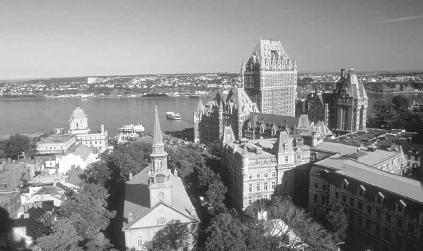
10 TRANSPORTATION
The St. Lawrence River's 2,330 miles (3,750 kilometers) of navigable length has been the transportation focus in Québec for 400 years. The expansion of farming, logging, and mining at the end of the 1800s helped with the original construction of the major arteries of the road system. Road transport is controlled by the Ministère des Transports du Québec (MTQ), while sea, air, and rail transport are mainly under federal control.
The 850-mile Grand Trunk Railroad first opened in 1856, connecting Québec City and Montréal to Toronto. Railroads are mostly operated by Canadian National (CN) and Canadian Pacific (CP). The preferred method of transport by manufacturers is often via railway, since much of Québec's exports are bulky natural resources (such as pulp and paper, lumber, and ore). The National Transportation Act of 1987 mandated the abandonment of unprofitable rail lines. As a result, much freight traffic has been switched from rail to road in Québec.
Most of the highway system was built in the 1960s, and today serves 80 percent of Québec's population, linking urban centers and connecting to the networks of Ontario and New England. In 2003, Québec had 4,396,004 registered road motor vehicles, 16,946 buses, 137,788 motorcycles and mopeds, and 1,223,180 trailers. During the winter, massive snow clearing and de-icing operations are necessary to keep roads open.
Public transportation companies serve about 3.5 million people and have almost 95 percent of the urban bus fleet. The MTQ is legally required by the Education Act to subsidize school busing. Ferries to the Côte-Nord region operate weekly from April to January.
In 1809, Canada's first steamer began operating between Montréal and Québec City, becoming the first mechanized transportation in Québec. Today, ferries throughout Québec annually carry over 5 million passengers and 1.7 million vehicles.
Canada's first canals were built around Montréal during 1779–83. The Rideau Canal opened in 1832 (at a cost of £1 million), providing a new route between Montréal and Lake Ontario. In 1843, the Cornwall Canal opened, providing a more direct route to Lake Ontario.
Québec has 78 commercial ports. The main ports are at Montréal and Québec City.
Québec has some 300 landing sites, public and private airports, seaplane bases, and heliports. Major international commercial air facilities are Montréal-Pierre Elliot Trudeau International Airport (formerly Dorval International Airport) and Mirabel International, both in the Montréal area. Other important commercial airports are at Québec City, Sept-Îles, Val-d'Or, Bagotville-Saguenay, Rouyn-Noranda, Mont-Joli, and Baie-Comeau. The MTQ also provides floatplane, ski-plane, and helicopter service for remote areas in the Côte-Nord region.
11 HISTORY
French Settlement
The eastern Canadian province of Québec was originally inhabited by members of the Algonquin and Iroquois tribes. The northern part of the province was, and still is, inhabited by the Inuit (previously known as "Eskimos").
The European history of Québec began with the arrival of the French explorer Jacques Cartier in 1534. During the years that followed, a thriving fur trade was established and a longstanding rivalry developed between French and English colonists. Québec City, founded in 1608, became the capital of New France. In the early years of the 21st century, the region was still regarded as the cradle of French-Canadian civilization.
French-English rivalry in North America led to the Seven Years' War (1756-1763). Québec City fell to British forces in 1759. With the Treaty of Paris in 1763, New France became a colony of Britain, but the Québec Act of 1774 gave official recognition to French civil laws, guaranteed religious freedom, and authorized the use of the French language in the region.
In 1791, the colony was divided in two. Large amounts of Loyalists (American colonists who wished to remain British subjects) fled north after the American Revolution to settle in western Québec. This led to the creation of Upper Canada (now Ontario) and Lower Canada (Québec). After rebellions in both regions in 1837, the two were reunited by the Act of Union and became the Province of Canada. In 1867, Québec became a founding member of the new Dominion of Canada, and Pierre-J.-O. Chauveau became its first premier. From the beginning, however, there were tensions between the French Canadians and the British.
Urbanization began in Québec at the end of the 19th century. Whereas only 16.6% of the province's population lived in urban centres in 1861, that number had jumped to almost 40% by 1901. The late nineteenth century also saw the formation of factory workers' unions in Québec. Laws were passed that prohibited employers from hiring girls under the age of 14 and boys under the age of 12, and weekly work hours were limited. Industrialization also took off in Québec at the end of the nineteenth century. Pulp and paper, mining, and aluminum industries were all developed in the regions of Saguenay-Lac Saint-Jean, Trois Rivières and Abitibi at this time, with most products destined for export to the United States.
War and Depression
Canada experienced losses of over 68,000 soldiers in World War I, and veterans returning to Québec faced a bleak future. Jobs were scarce and low paying, and tariffs (taxes) on imports kept prices for consumer goods high. Local farmers were hit hard by falling wheat prices in the postwar period.
For a long time, Québec's rural roots and domination by the Roman Catholic Church made it a traditional agrarian (farming) society. But in the 1920s, another wave of urbanization hit the province, bringing with it higher living standards. Grain prices recovered, and Canadian industry grew even more. Improvements to roads and railways enabled businesses to grow, and automobiles, telephones, electrical appliances, and other consumer goods became widely available.
All of Canada suffered during the Great Depression, a period of severe economic slowdown that began in 1929. In addition to the problems with grain prices during the early 1920s, droughts and frequent crop failures devastated the national economy, which still relied heavily on agriculture. Social welfare programs expanded rapidly during the 1930s to help the people of Canada through this especially difficult time. The Union Nationale, established by Maurice Duplessis, came to power in Québec in the 1930s. With the support of the Roman Catholic Church, the government launched a "back-to-the-land" movement, encouraging families to move from the city and settle in the regions of Gaspé, Côte Nord and Abitibi. Ultimately, the movement was unsuccessful, since the farms were isolated and located in areas where growing conditions were poor.
Following World War II (1939–45), consumer spending and immigration to Canada increased rapidly. Urbanization spread through most parts of Canada, but not to Québec, where Duplessis remained
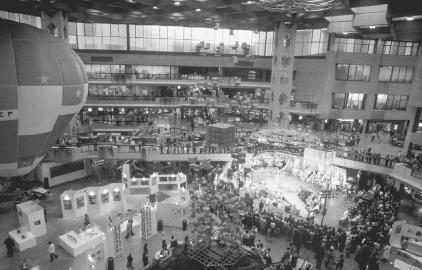
A Period of Transition
Beginning in 1960, Québec entered a period of transition: the "Quiet Revolution." It was an era marked by rapid economic expansion, cultural pride, and the overhauling of political institutions to meet the needs of contemporary society. In 1967, Canada's centennial anniversary, the world's fair was held in Montréal.
From this time onward, political tensions ran high as the province sought to assume greater control over its economy and society. The early 1970s were marked by hostility as acts of terrorism, politically motivated murders, and violent labor strikes struck Quebec. In 1976, Quebeckers elected the Parti Québécois (PQ), a party that sought independence for the region. The PQ made French the official language of Québec, and, as a result, many English-speaking people and their companies left the province.
The Question of Secession
Canada's unity has been threatened by the possibility of Québec's secession, or separation, from the rest of the country. As a French-speaking area that places high value on the preservation of its French culture, Québec has found itself in a unique position: key issues of concern for its residents are the survival of all things French. Quebeckers felt that the Canadian Constitution of 1982 did not address their cultural concerns sufficiently. When Robert Bourassa became Premier of Québec in December 1985, he demanded five minimum conditions be met before he would sign the Canadian Constitution. These demands set off the negotiations that resulted in the Meech Lake Accord (1987) and the Charlottetown Accord (1992).
The Meech Lake and Charlottetown accords both proposed the recognition of Québec as a "distinct society" within the nation. The Canadian government had hoped that these accords would alleviate Québec's fears of cultural loss and discrimination while maintaining a unified Canada. But both accords were rejected in a general vote.
If Québec does eventually secede from the rest of the country, Canada would lose a large percentage of its population, money, and power. Moreover, the ability for the remainder of Canada to stay unified would also be seriously impaired. For example, the fate of the traditionally poorer Maritime Provinces to the east would be uncertain, and one or more of them might explore the possibility of admission to the United States. Although a referendum in 1995 did not result in secession, the margin was so narrow that Québec's separation issue remained unresolved.
In January 1998, a blackout left 3 million people without power at the peak of a five-day storm. In response to the ice storm, the Canadian army undertook its biggest-ever peacetime deployment, sending more than 14,000 soldiers to the affected areas of Québec and Ontario. The blackout occurred when transmission lines fell from the weight of ice.
On 1 December 1998, voters returned Québec's separatist premier, Lucien Bouchard, to power but made clear there was no overwhelming support for secession. With only 43 percent of the vote, Parti Québécois still controlled the legislature, but lacked the mandate to push quickly for independence. Bouchard pledged to hold such a referendum only when confident the separatists could win, but retired in 2001 before realizing his goal. Bernard Landry was then elected as the leader of the party and premier of Québec.
In 1999, a Canadian Supreme Court ruling declared that same-sex couples were entitled to the same benefits and obligations as opposite-sex couples in long-term relationships that the government recognizes as "common law" marriages. The Québec legislature later amended its civil code to mandate equal treatment for same-sex partners.
12 PROVINCIAL GOVERNMENT
The parliamentary system is based on both the French and British systems. Québec's National Assembly is the chief parliamentary body, with 125 elected representative members. The National Assembly's prime minister is the majority party leader (an elected member of parliament) who serves a term of five years, at the end of which time he or she must call an election. The prime minister selects and presides over the 25 members of the executive cabinet.
13 POLITICAL PARTIES
In theory, Québec has a multiparty system, but in reality there are two main parties (Liberal and Conservative), with one or two others receiving a small proportion of votes. Since the 1940s, various splinter groups such as the nationalist Bloc Populaire, the créditiste Union des Electeurs, the separatist Rassemblement pour l'Indépendence Nationale, Ralliement Nationale, and more recently Parti Québécois have occasionally challenged the traditional two-party rule. Since 1939, the Liberal Party has been especially popular among the urban electorate.
In 1976, voters elected into majority power the Parti Québécois (PQ), a party wanting independence for Québec. The PQ made French the sole, official language of Québec, and, in 1980, conducted a referendum on negotiating an arrangement for sovereignty-association with Canada. In 1995, another referendum was held regarding the possibility of secession. Both referenda were defeated, although the 1995 referendum lost by only one percent.
The most recent general election was held on 14 April 2003, in which the separatist Parti Québécois won 45 of the legislature's 125 seats, while the anti-separatist Québec Liberal Party won 76. Democratic Action won 4 seats.
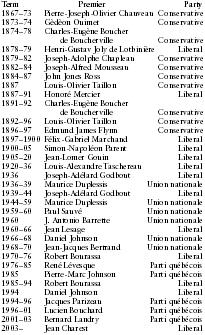
| Term | Premier | Party |
| 1867–73 | Pierre-Joseph-Olivier Chauveau | Conservative |
| 1873–74 | Gèdèon Ouimet | Conservative |
| 1874–78 | Charles-Eugène Boucher de Boucherville | Conservative |
| 1878–79 | Henri-Gustav Joly de Lotbinière | Liberal |
| 1879–82 | Joseph-Adolphe Chapleau | Conservative |
| 1882–84 | Joseph-Alfred Mousseau | Conservative |
| 1884–87 | John Jones Ross | Conservative |
| 1887 | Louis-Olivier Taillon | Conservative |
| 1887–91 | Honoré Mercier | Liberal |
| 1891–92 | Charles-Eugène Boucher de Boucherville | Conservative |
| 1892–96 | Louis-Olivier Taillon | Conservative |
| 1896–97 | Edmund James Flynn | Conservative |
| 1897–1900 | Félix-Gabriel Marchand | Liberal |
| 1900–05 | Simon-Napoléon Parent | Liberal |
| 1905–20 | Jean-Lomer Gouin | Liberal |
| 1920–36 | Louis-Alexandre Taschereau | Liberal |
| 1936 | Joseph-Adélard Godbout | Liberal |
| 1936–39 | Maurice Duplessis | Union nationale |
| 1939–44 | Joseph-Adélard Godbout | Liberal |
| 1944–59 | Maurice Duplessis | Union nationale |
| 1959–60 | Paul Sauvé | Union nationale |
| 1960 | J. Antonio Barrette | Union nationale |
| 1960–66 | Jean Lesage | Liberal |
| 1966–68 | Daniel Johnson | Union nationale |
| 1968–70 | Jean-Jacques Bertrand | Union nationale |
| 1970–76 | Robert Bourassa | Liberal |
| 1976–85 | René Lévesque | Parti québécois |
| 1985 | Pierre-Marc Johnson | Parti québécois |
| 1985–94 | Robert Bourassa | Liberal |
| 1994 | Daniel Johnson | Liberal |
| 1994–96 | Jacques Parizeau | Parti québécois |
| 1996–01 | Lucien Bouchard | Parti québécois |
| 2001–03 | Bernard Landry | Parti québécois |
| 2003– | Jean Charest | Liberal |
14 LOCAL GOVERNMENT
Québec is divided into 16 administrative regions, 99 regional county municipalities, and three urban communities (Montréal, Québec City, and Outaouais). Rural municipalities are classified as villages, parishes, townships, united townships, not designated, and Indian reserves. Cities and towns are both often referred to as "villes." Special municipal legislation calls for more governmental autonomy for Montréal, Québec City, and the Cree and Northern villages organized under the James Bay Agreement in 1975.
15 JUDICIAL SYSTEM
The Canadian Constitution grants provincial jurisdiction over the administration of justice, and allows each province to organize its own court system and police forces. The federal government has exclusive domain over cases involving trade and commerce, banking, bankruptcy, and criminal law. The Federal Court of Canada has both trial and appellate divisions for federal cases. The nine-judge Supreme Court of Canada is an appellate court that determines the constitutionality of both federal and provincial statutes. The Tax Court of Canada hears appeals of taxpayers against assessments by Revenue Canada.
The judiciary is independent of legislative or executive powers, and administers the Civil Code of Québec and the Canadian Penal Code. The Civil Code of Québec is based on the Napoleonic Code, which was developed in France.
The provincial court system consists of the Court of Québec, which is the trial court hearing criminal, civil, and youth matters; the Superior Court of Québec, which has both Montréal and Québec divisions, and hears serious civil and criminal cases, as well as administrative and family matters, and bankruptcies; and the Court of Appeal of Québec, which is the province's highest court.
In 2002, there were 118 homicides in Québec. That year, there were 719 violent crimes per 100,000 persons, and 3,339 property crimes per 100,000 persons.
16 MIGRATION
Between 1608 and 1756, some 10,000 French settlers arrived in Canada. Since the end of World War II, more than 650,000 immigrants from over 80 countries have moved to Québec, particularly to the city of Montréal. Italians and Eastern Europeans were traditionally the largest immigrant groups to settle in Québec, but since 1960 the ranks of new Québeckers have been swollen by Portuguese, Haitians, Lebanese, South Americans, and Southeast Asians. In 1968, the Québec government created its own department of immigration, the only such provincial office in Canada.
In 2001, 18.2 percent of the 706,965 immigrants living in Québec had come from Southern Europe. About 11.8 percent had come from Northern and Western European countries (other than the United Kingdom). Some 11.5 percent came from Africa, and 9.9 percent came from the Caribbean and Bermuda. Many immigrants in recent years have come from Italy, Haiti, France, Lebanon, China, and Romania. About 90 percent of all immigrants live in Montréal.
In 2001, 2 percent of Québec's residents age 5 and older were living abroad. Some 16.2 percent were living elsewhere in Québec, while 0.9 percent were living in another province. Ontario is the leading province of origin for most internal migration into Québec. Most of Québec's residents who leave the province to live elsewhere in Canada relocate to Ontario.
17 ECONOMY
Québec's economy is highly industrialized and quite diversified. The province has abundant natural resources and energy, along with well-developed agriculture, manufacturing, and service sectors. The service sector is by far the largest sector of the economy, followed by manufacturing; finance, insurance, and real estate; public administration and defense; retail trade; wholesale trade; transportation; utilities; agriculture, forestry, fishing, and mining; communications; and warehousing. In 2002, the gross domestic product was C$245.6 billion, or 21.3 percent of the national total.
18 INCOME
Average family income in the province was C$60,227 in 2000 for a family of five. As of 2000, average weekly earnings in the province amounted to C$584.53.
19 INDUSTRY
Québec's manufacturing sector produces a wide variety of high quality products for export, such as air traffic control equipment, software, subway trains, helicopters, compact discs, air purifiers, and toys. More than 60 percent of the province's manufacturing firms are small or mediumsized companies. Montréal accounts for 70 percent of Québec's manufacturing production and is especially strong in space and aeronautics, telecommunications, energy, and transportation. In 2002, the value of manufacturers' shipments totaled over C$122 billion.
The high-technology sector and the transportation manufacturing sector felt the adverse effects of the global economic downturn in 2001. In 2002, the province lost its only automobile manufacturing plant. A decision by the United States to impose a 29 percent duty on Canadian lumber had a negative impact on that industry. A pulp and paper mill was to resume operation in 2003, however. Those industries in Québec that depend directly on natural resources were growing in 2002 and 2003.
20 LABOR
In 2003, Québec's labor force numbered around 4.05 million, with 3.69 million employed and about 353,900 unemployed, giving an unemployment rate of 8.7 percent. The hourly minimum wage as of January 2004 was C$7.30.
The sectors with the largest numbers of employed persons in 2003 were manufacturing, 646,500; trade, 614,500; health care and social services, 445,300; educational services, 252,400; accommodation and food services, 222,400; public administration, 217,100; professional, scientific, and technical services, 213,600; finance, insurance, and real estate and leasing, 190,000; construction, 174,300; other services, 168,500; transportation and warehousing, 165,600; information, culture, and recreation, 162,000; management, administrative, and other support, 111,700; agriculture, 57,700; forestry, fishing, mining, and oil and gas, 37,800; and utilities, 29,100.
21 AGRICULTURE
In 2001, Québec had over 8.5 million acres (3.4 million hectares) in 32,139 farms, of which 4.6 million acres (1.8 million hectares) were in crops. The primary field crops are hay, fodder corn, alfalfa, barley, and soybeans. The top three fruit crops grown are blueberries, apples, and strawberries. The top three field-grown vegetable crops are sweet corn, green or wax beans, and green peas. Carrots, green cabbage, onions, potatoes, wheat, and tobacco are also grown.
Québec has 1,159 farms with greenhouses under glass, plastic, or other protection. There are 60 sod farms, 395 farms growing Christmas trees, and 627 farms growing nursery products. In 2001, 372 farms reported growing certified organic products.
Farm receipts in 2000 (excluding forest products sold) totaled C$6.1 billion. Farmers' operating expenses equaled C$5.1 billion. The average farmer was left with C$32,304 before interest payments and taxes.
22 DOMESTICATED ANIMALS
Dairy, beef, pork, and poultry production significantly contribute to provincial self-sufficiency in food. Québec has over 23,000 livestock farms, covering over 1 million acres. Over 50 percent are dairy farms. There are also about 140 farms that raise foxes and minks for their pelts. In 2003, cash receipts from livestock products totaled C$3.79 billion. In 2001, there were 1.36 million head of cattle, 407,206 dairy cows, 4.27 million pigs, and 254,053 sheep. The poultry population in 2003 was 7.36 million. There were 737 chicken producers, 148 turkey producers, and 111 egg producers.
23 FISHING
Commercial fishing in Québec benefits from some of the most productive fishing areas in the Atlantic as well as large consumer markets for fish and fish products. Québec has around 1,800 registered commercial fishing vessels. About 75 percent of the annual provincial fisheries production is exported, especially crustaceans and shellfish. Production from aquaculture (fish farming) centers around trout and salmon. In 2003, 23,520 tons of fish and shellfish, valued at C$187.7 million, were exported from Québec.
In 2000, Québec had 813,590 residents actively engaged in sport fishing within the province.
24 FORESTRY
Québec's forests cover 207.3 million acres (83.9 million hectares). About 62 percent of Québec's lands are covered with forests, of which 58 percent is softwood. About 89 percent is provincial Crown land, while 11 percent is owned privately. Major softwood species include white, black, and red spruce as well as balsam fir and eastern white pine. Common hardwood species include sugar and red maple, trembling aspen, paper and yellow birch, and American beech. In 2000, the total timber harvest
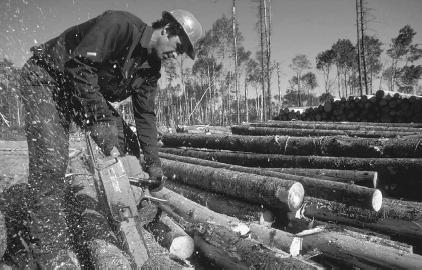
25 MINING
Québec is one of the world's 10 leading mineral producers. Metallic minerals predominate and include gold, copper, nickel, zinc, silver, iron, and asbestos. Gold production in 2003 was 28,109 kilograms (61,969 pounds) valued at C$457.2 million. Québec also produces large amounts of cement and stone. The total value of mineral production in 2003 was C$3.65 billion, to which metals contributed 64 percent, and industrial minerals, 36 percent.
26 ENERGY AND POWER
Québec is not a significant producer of petroleum, natural gas, or coal. The industrial sector accounts for 60 percent of natural gas consumption in Québec, and the federal government has recently encouraged industrial conversion from oil to natural gas.
Québec has enormous hydroelectric resources; electricity output increased 132 percent between 1971 and 1991. Hydroelectricity is controlled by Hydro-Québec, a state-owned company that distributes electricity throughout Québec, the maritime provinces, and to much of New England. As of 2003, 96 percent of Québec's energy needs were met by hydroelectricity. That year, 2 percent of the province's energy needs were met by nuclear power, 1.7 percent by thermal sources, and 0.3 percent by other sources.
In 2004, Hydro-Québec was in the process of developing additional large-scale hydroelectric facilities. It was expanding ties with the US. In 2004, Hydro One (from Ontario) and Hydro-Québec were developing a 1,250 megawatt high voltage direct current transmission line linking Ontario and Québec. Links between Québec and Connecticut, Long Island, northern New Jersey and New York, and either Ohio or Pennsylvania were being planned by Hydro-Québec as of 2004.
In January 1998, a blackout left 3 million people without power at the peak of a five-day storm. About 400,000 HydroQuébec customers went three weeks without power. The blackout occurred when transmission lines fell from the weight of ice.
27 COMMERCE
In 2002, total merchandise exports amounted to C$68.4 billion. Imports totaled C$51.4 billion. The United States took in 83.6 percent of Québec's merchandise exports, and supplied 37.3 percent of its imports. Other export markets were Germany, the United Kingdom, France, and the Netherlands. Import suppliers include the United Kingdom, China, France, and Germany.
Major export areas for Québec include the forest industry (printing, lumber and paper), mining (aluminum and iron ore) and transportation equipment manufacturing (including aircrafts and parts).
28 PUBLIC FINANCE
The fiscal year runs from 1 April to 31 March. For fiscal year 2002/03, Québec had a balanced budget. Total revenues were C$51.9 billion and expenditures totaled C$51.9 billion. The largest expenditure items were health and social services, education, finance, income security, health insurance, transport, and municipal affairs. In the 2002/03 fiscal year, provincial debt amounted to 39.2 percent of the gross domestic product.
29 TAXATION
The retail sales tax was 7.5 percent in 2003. Major consumption taxes are levied on gasoline (C$0.152 per liter) and tobacco (C$18.10 per carton). The basic personal income tax rate for the province was 48.4 percent in 2003. This was the second highest rate among the provinces, behind British Columbia.
The average family of four (two parents and two children) in 2003 earned C$81,057. Such a family paid C$41,068 in taxes.
Corporate income tax rates in 2003 were as follows: small business rate, 8.9 percent; general business rate, 8.9 percent; and capital tax rate, 0.6–1.45 percent. Although personal income taxes are among the highest in Canada, corporations in Québec have one of the lowest overall tax rates on profits in North America.
30 HEALTH
In 2001, there were 73,695 live births in Québec, an increase of 2.3 percent over 2000. Québec was one of only four provinces or territories with an increase in the number of live births in 2001. There were 54,194 deaths that year, an increase of 1.9 percent. Québec was also one of only four provinces or territories that had an increase in the number of deaths in 2001. Life expectancy for men in 2001 was 77.5 years, and 82.2 years for women. Reported cases of selected diseases in 2002 included campylobacteriosis, 2,541; salmonellosis, 1,213; giardiasis, 949; gonococcal infections, 878; and hepatitis type B, 255. Between November 1985 and June 2003, 10,948 residents had become infected with HIV, the virus that causes AIDS. Québec has over 700 health establishments.
31 HOUSING
Québec had 2,978,115 households in 2001. The average household size was 2.4 persons. There were 1,370,505 households living in single-detached houses, 154,220 households living in apartments in buildings with five or more stories, 21,360 households living in mobile homes, and 1,432,025 households living in other dwellings, including row houses and apartments in buildings with fewer than five stories. In 2002, C$11.1 billion was invested in residential housing construction.
32 EDUCATION
Schooling is available in both French and English. In 2000, Québec had 1,131,585 students enrolled in elementary and secondary schools. In most schools, French is the language of instruction. The Ministère de l'Éducation (ME, Ministry of Education) is responsible for determining which educational services are to be provided in the school system. Historically public schools were either Roman Catholic or Protestant. In the early 1990s, however, legislation was passed to eliminate the religious nature of the schools and to reorganize the system into French-language and English-language schools. Many students attend two years of preschool, followed by six years of elementary school, five years of secondary school, and two years of college. Elemetary, secondary, and college education is free. College students choose either vocational or pre-university programs. Students who continue to university must pay tuition. As of 2000, over one-fourth of Québec students went on to earn a bachelor's degree. In 2003/04, average undergraduate tuition fees in Québec were $1,862 a year, the lowest in Canada.
The ME is responsible for managing higher education at Québec's colleges. The 47 public colleges as well as 10 other institutions
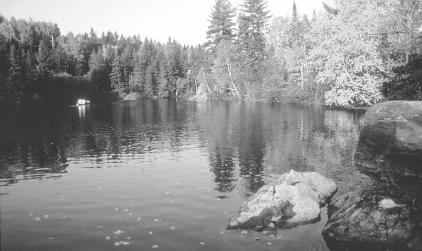
The Université du Québec in Québec City, founded in 1968, is the second-largest university in Canada and the nation's largest French-language higher education institution. Other universities (with location and year founded) include Universit é Laval (Québec City, 1852); McGill University (Montréal, 1821); Université de Montréal (1920); Concordia University (Montréal, 1974); Université de Sherbrooke (1954); and Bishop's University (Lennoxville, 1843). Four of the province's seven universities offer courses taught in French (Université Laval, Université de Montréal, Université de Sherbrooke, and Université du Québec); the other three offer instruction in English (McGill, Bishop's, and Concordia).
33 ARTS
Québec, with the Grands Ballet Canadiens, is well-known for its numerous dance companies, and a North American center for dance. Montréal annually hosts the Festival international de nouvelle danse, which attracts dance professionals from around the world. Montréal also has some 50 theaters and 20 permanent theater companies that stage traditional works as well as a repertory from Québec's avant-garde playwrights. Québec also offers several yearly music festivals, including a classical music competition, the Festival international de Lanaudière, and the International Jazz Festival, all in Montréal; the Festival d'été de Québec (a summer music festival) is held in Québec City. Cinema productions by the National Film Board of Canada in Québec have included Denys Arcand's The Decline of the American Empire and Jesus of Montréal, Frédérick Back's The Man Who Planted Trees, and Jason Young's Animals, which won the award for best documentary at the 2003 Atlantic Film Festival. In 2000/01, per capita provincial spending on the arts in Québec was C$99, higher than the national average of C$68.
34 LIBRARIES AND MUSEUMS
Québec has 165 public library systems, with 929 branches. The Université du Québec and McGill University maintain large academic libraries in Montréal. Other large academic libraries include those of Université de Sherbrooke, Universit é de Montréal, and Université Laval (Québec City).
The Musée du Québec in Québec City is one of Canada's most prominent museums, with a distinguished collection of 17th–19th century art as well as a collection of contemporary art. Montréal has some 20 museums and many art galleries, including the McCord Museum of Canadian History, Montréal Museun of Modern Art, and the International Museum of Cartoon Art. Biosphere, built for the 1967 World's Fair, has been operated as a museum by Environment Canada since 1995. The Canadian Museum of Civilization is located in Hull.
35 COMMUNICATIONS
The government offers subsidies for radio programming by and about aboriginal (native) Canadians. As of 2004, there were 6 AM, 29 FM, 7 Internet radio stations, and 6 television stations broadcasting in the Montréal area. About 77 percent of all television programming is in French. Montréal produces 65 percent of the world's French-language television programming and original productions. Montréal is also Canada's main routing center for international telecommunications connections—including one of the world's first digital telephone switching systems.
36 PRESS
Montréal's dailies are Le Journal de Montréal, La Presse, Le Devoir, and The Gazette; Québec City has Le Journal de Québec and Le Soleil. More than 500 publications are printed in Québec, with over 400 in French and 75 in English. Québec has about 100 publishers and a dozen annual book fairs.
37 TOURISM, TRAVEL, AND RECREATION
Québec is famous for its expansive system of large urban parks; the province maintains 20 parks and wildlife reserves. The taiga and tundra of the north is a popular destination for adventurous travelers. Montréal's Botanical Garden, the second largest in the world, has ornate Chinese
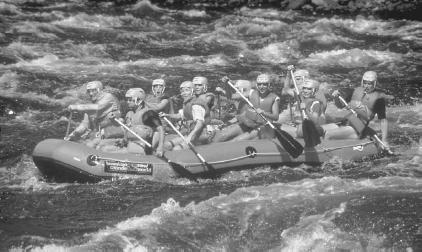
38 SPORTS
Professional sports teams include the Montréal Canadiens of the National Hockey League (NHL) and the Montréal Expos of Major League Baseball, the first franchise the league awarded outside the United States. The Canadiens are the best-known team in hockey and have won the NHL championship (the Stanley Cup) a record 23 times—the earliest in 1924 and the most recent in 1993. The Quebec Nordiques played in the NHL from 1979 to 1996 before the franchise became the Colorado Avalanche. The Montréal Alouettes of the Canadian Football League won the Grey Cup in 1970, 1974, 1977, and 2002. The Québec Capitales, a minor league baseball team in the Northern League, completed their inaugural season in 1999.
Professional women's hockey is played by the Montreal Axion and Québec Avalanche in the National Women's Hockey League (NWHL).
Major sporting events in Québec include an international tennis tournament, the Formula 1 Grand Prix, the Grand Prix cycliste des Amériques, the Valleyfield International Regatta, the international swim across Lac Saint-Jean, and the Harricana snowmobile rally from southern Québec to James Bay. Montréal hosted the summer Olympics in 1976.
Popular summer recreational activities include sailing, golf, cycling, swimming, and tennis. Downhill skiing on world-class slopes, cross-country skiing, and ice hockey and skating are popular winter activities.
39 FAMOUS QUÉBÉCOIS/QUÉBECKERS
Early explorers included Jacques Cartier (b.France, 1491–1557), who navigated up the St. Lawrence River. Geographer Samuel de Champlain (b.France, 1570–1635), the "Father of New France," also led expeditions and organized settlements. Étienne Brûlé (b.France, c.1592–c.1633) was the first European explorer to live among the Aboriginal people and translated the Huron language. Louis de Buade, Comte de Palluau et de Frontenac (b.France, 1622–98), was the greatest of the French royal governors and promoted French expansion into North America by establishing fur-trade posts and defending them against the Iroquois and the English. Louis Jolliet (1645–1700) was commissioned by Frontenac to explore the Mississippi River. Fur trader James McGill (b.Scotland, 1744–1813) was the founder of the university in Montréal that bears his name.
Sir John Abbott (1821–93), Canada's first native-born prime minister, was from St. Andrews, Lower Canada (Québec). Other prominent political leaders from Québec include Canadian prime ministers Sir Wilfred Laurier (1841–1919), Louis St. Laurant (1882–1973), Pierre Trudeau (1919–2000), Brian Mulroney (b.1939), and Jean Chrétien (b.1934). Ren é Lévesque (1922–87) led the separatist Parti Québécois to power in 1976 and served as Québec's premier until 1985. Lucien Bouchard (b.1938) is the leader of the Bloc Québécois, a political party that desires the independence of Québec from Canada.
Famous entertainers from Québec include actors Glenn Ford (b.1916), Joseph Wiseman (b.1918), Madeleine Sherwood (b.1926), William Shatner (b.1931), John Vernon (b.1932), Michael Sarrazin (b.1940), Geneviève Bujold (b.1942), and Robert Joy (b.1951); director and producer Paul Almond (b.1931); pianist Oscar Peterson (b.1925); operatic singer Maureen Forrester (b.1930) and baritone Louis Quilico (1931–2000); and singers Leonard Cohen (b.1934), Burton Cummings (b.1947), and Corey Hart (b.1962).
Noted francophone Québecois authors include novelists Yves Thériault (1915–83), Roger Lemelin (1919–92), and Hubert Aquin (1929–77); and poets François-Xavier Garneau (1809–66), Octave Crémazie (1827–79), Émile Nelligan (1879–1941), Gratien Gélinas (1909–99), Anne Hébert (1916–2000), and Roch Carrier (b.1937). Famous anglophone authors include critic Northrop Frye (1912–91), novelists Constance Beresford-Howe (b.1922), Mordecai Richler (b.1931); short story writer Mavis Gallant (b.1922); and poet F. R. Scott (1899–1985). Distinguished Québec authors known for their works in both French and English include novelist Marie-Claire Blais (b.1939), poet and novelist Nicole Brossard (b.1943), and playwright Michel Tremblay (b.1942). Sculptor Akeeaktashuk (1898–1954) was one of the first Inuit artists to receive individual acclaim.
Québec has been the home of many great hockey players, including Maurice "Rocket" Richard (1921–2000), Jacques Plante (1929–86), Jean Beliveau (b.1931), Bernie "Boom Boom" Geoffrion (b.1931), Rodrique "Rod" Gilbert (b.1941), Yvan Serge Cournoyer (b.1943), Bernard Marcel Parent (b.1945), Marcel Dionne (b.1951), Guy Damien Lafleur (b.1951), Richard Lionel "Rick" Martin (b.1951), Denis Charles Potvin (b.1953), Jean Ratelle (b.1953), Mike Bossy (b.1957), and Mario Lemieux (b.1965).
40 BIBLIOGRAPHY
Ferry, Steven. Québec. San Diego: Lucent, 2003.
Kizilos, Peter. Québec: Province Divided. Minneapolis: Lerner, 2000.
LeVert, Suzanne. Québec. Philadelphia: Chelsea House, 2001.
Sorensen, Lynda. Canada: Provinces and Territories. Vero Beach, FL: Rourke Book Co., 1995.
Web sites
Québec Government Portal. http://www.gouv.qc.caIndex_en.html (accessed on March 22, 2004).
Statistics Canada. http://www.statcan.ca/start.html (accessed on March 22, 2004).
Travel Canada: Québec. http://www.travelcanada.ca/tc_redesign/app/en/ca/destinations.do?provinceId=12 (accessed on March 22, 2004).
Comment about this article, ask questions, or add new information about this topic: